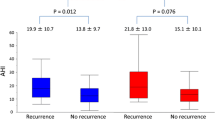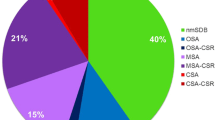Abstract
Sleep-disordered breathing (SDB) is recognized as a primary factor or mediator of atrial fibrillation (AF). We hypothesized that the severity of SDB among AF ablation candidates would be associated with left ventricular diastolic dysfunction (LVDD) even for subclinical SDB. A total of 246 patients hospitalized for initial pulmonary vein isolation (PVI) were analyzed. Known SDB cases were excluded. We measured the oxygen desaturation index (ODI) by pulse oximetry overnight as an indicator of SDB, and classified SDB severity by 3 % ODI as normal (ODI < 5 events/h), mild (ODI ≤ 5 to <15 events/h), or moderate-to-severe (ODI ≥15 events/h). The LVDD was assessed by echocardiography using combined categories with tissue Doppler imaging and left atrial (LA) volume measurement. Among the participants, 42 patients (17.1 %) had LVDD. The prevalence of LVDD increased with the SDB severity from 8.6 % (normal) to 12.7 % (mild) to 40.0 % (moderate-to-severe SDB) (p < 0.0001). In the multivariate logistic regression analysis, the odds ratio of having LVDD in the moderate-to-severe SDB group (ODI ≥ 15) vs. normal group (ODI < 5) was 5.96 (95 % CI, 2.10–19.00, P = 0.006). The presence of moderate-to-severe SDB in AF ablation candidates adversely affected LV diastolic function even during a subclinical state of SDB.


Similar content being viewed by others
References
Gami AS, Pressman G, Caples SM, Kanagala R, Gard JJ, Davison DE, Malouf JF, Ammash NM, Friedman PA, Somers VK (2004) Association of atrial fibrillation and obstructive sleep apnea. Circulation 110:364–367
Digby GC, Baranchuk A (2012) Sleep apnea and atrial fibrillation; 2012 Update. Curr Cardiol Rev 8:265–272
Monahan K, Brewster J, Wang L, Parvez B, Goyal S, Roden DM, Darbar D (2012) Relation of the severity of obstructive sleep apnea in response to anti-arrhythmic drugs in patients with atrial fibrillation or atrial flutter. Am J Cardiol 110:369–372
Kanagala R, Murali NS, Friedman PA, Ammash NM, Gersh BJ, Ballman KV, Shamsuzzaman AS, Somers VK (2003) Obstructive sleep apnea and the recurrence of atrial fibrillation. Circulation 107:2589–2594
Bitter T, Nölker G, Vogt J, Prinz C, Horstkotte D, Oldenburg O (2012) Predictors of recurrence in patients undergoing cryoballoon ablation for treatment of atrial fibrillation: the independent role of sleep-disordered breathing. J Cardiovasc Electrophysiol 23:18–25
Fein AS, Shvilkin A, Shah D, Haffajee CI, Das S, Kumar K, Kramer DB, Zimetbaum PJ, Buxton AE, Josephson ME, Anter E (2013) Treatment of obstructive sleep apnea reduces the risk of atrial fibrillation recurrence after catheter ablation. J Am Coll Cardiol 62:300–305
Patel D, Mohanty P, Di Biase L, Shaheen M, Lewis WR, Quan K, Cummings JE, Wang P, Al-Ahmad A, Venkatraman P, Nashawati E, Lakkireddy D, Schweikert R, Horton R, Sanchez J, Gallinghouse J, Hao S, Beheiry S, Cardinal DS, Zagrodzky J, Candy R, Bailey S, Burkhardt D, Natale A (2010) Safety and efficacy of pulmonary vein antral isolation in patients with obstructive sleep apnea: the impact of continuous positive airway pressure. Circ Arrhythm Electrophysiol 3:445–451
Kim SH, Cho GY, Shin C, Lim HE, Kim YH, Song WH, Shim WJ, Ahn JC (2008) Impact of obstructive sleep apnea on left ventricular diastolic function. Am J Cardiol 101:1663–1668
Butt M, Dwivedi G, Shantsila A, Khair OA, Lip GYH (2012) Left ventricular systolic and diastolic function in obstructive sleep apnea: impact of continuous positive airway pressure therapy. Circ Heart Fail 5:226–233
Oldenburg O, Lamp B, Faber L, Teschler H, Horstkotte D, T¨opfer V (2007) Sleep-disordered breathing in patients with symptomatic heart failure: a contemporary study of prevalence in and characteristics of 700 patients. Eur J Heart Fail 9:251–257
Takeda T, Nishimura Y, Satouchi M, Kamiryo H, Takenaka K, Kasai D, Urata Y, Kobayashi K, Shimada T, Yoshimura S, Nishiuma T, Yokoyama M (2006) Usefulness of the oximetry test for the diagnosis of sleep apnea syndrome in Japan. Am J Med Sci 331:304–308
Ling IT, James AL, Hillman DR (2012) Interrelationships between body mass, oxygen desaturation, and apnea-hypopnea indices in a sleep clinic population. Sleep 35:89–96
Nakamata M, Kubota Y, Sakai K, Kinefuchi S, Nakayama H, Ohdaira T, Sato M, Shinoda H, Kouno M (2003) The limitation of screening test for patients with sleep apnea syndrome using pulse oximetry (in Japanese with English abstract). J Jpn Soc Respir Care 12:401–406
Nagueh SF, Kopelen HA, Quinones MA (1996) Assessment of left ventricular filling pressures by Doppler in the presence of atrial fibrillation. Circulation 94:2138–2145
Lang RM, Bierig M, Devereux RB, Flachskampf FA, Foster E, Pellikka PA, Picard MH, Roman MJ, Seward J, Shanewise J, Solomon S, Spencer KT, St John Sutton M, Stewart W (2006) Recommendations for chamber quantification. Eur J Echocardiogr 7:79–108
Tsang TSM, Barnes ME, Gersh BJ, Bailey KR, Seward JB (2002) Left atrial volume as a morphophysiologic expression of left ventricular diastolic dysfunction and relation to cardiovascular risk burden. Am J Cardiol 90:1284–1289
Nagueh SF, Appleton CP, Gillebert TC, Marino PN, Oh JK, Smiseth OA, Waggoner AD, Flachskampf FA, Pellikka PA, Evangelista A (2009) Recommendations for the evaluation of left ventricular diastolic function by echocardiography. J Am Soc Echocardiogr 22:107–133
Moller JE, Pellikka PA, Hillis GS, Oh JK (2006) Prognostic importance of diastolic function and filling pressure in patients with acute myocardial infarction. Circulation 114:438–444
Camm AJ, Kirchhof P, Lip GY, Schotten U, Savelieva I, Ernst S, Van Gelder IC, Al-Attar N, Hindricks G, Prendergast B, Heidbuchel H, Alfieri O, Angelini A, Atar D, Colonna P, De Caterina R, De Sutter J, Goette A, Gorenek B, Heldal M, Hohloser SH, Kolh P, Le Heuzey JY, Ponikowski P, Rutten FH, ESC Committee for Practice Guidelines (2010) Guidelines for the management of atrial fibrillation: the task force for the management of atrial fibrillation of the European Society of Cardiology (ESC). Europace 12:1360–1420
Arias MA, García-Río F, Alonso-Fernández A, Mediano O, Martí I, Villamor J (2005) Obstructive sleep apnoea syndrome affects left ventricular diastolic function: effects of nasal continuous positive airway pressure in men. Circulation 112:375–383
Wanahita N, Messerli FH, Bangalore S, Gami AS, Somers VK, Steinberg JS (2008) Atrial fibrillation and obesity—results of a meta-analysis. Am Heart J 155:310–315
Dimitri H, Ng M, Brooks AG, Kuklik P, Stiles MK, Lau DH, Antic N, Thornton A, Saint DA, McEvoy D, Antic R, Kalman JM, Sanders P (2012) Atrial remodeling in obstructive sleep apnea: implications for atrial fibrillation. Heart Rhythm 9:321–327
Pritchett AM, Mahoney DW, Jacobsen SJ, Rodeheffer RJ, Karon BL, Redfield MM (2005) Diastolic dysfunction and left atrial volume: a population-based study. J Am Coll Cardiol 45:87–92
Schneider C, Malisius R, Krause K, Lampe F, Bahlmann E, Boczor S, Antz M, Ernst S, Kuck KH (2008) Strain rate imaging for functional quantification of the left atrium: atrial deformation predicts the maintenance of sinus rhythm after catheter ablation of atrial fibrillation. Eur Heart J 29:1397–1409
Bazzano LA, Khan Z, Reynolds K, He J (2007) Effect of nocturnal nasal continuous positive airway pressure on blood pressure in obstructive sleep apnea. Hypertension 50:417–423
Peppard PE, Young T, Palta M, Skatrud J (2000) Prospective study of the association between sleep-disordered breathing and hypertension. N Engl J Med 342:1378–1384
Haentjens P, Van Meerhaeghe A, Moscariello A, De Weerdt S, Poppe K, Dupont A, Velkeniers B (2007) The impact of continuous positive airway pressure on blood pressure in patients with obstructive sleep apnea syndrome. Arch Intern Med 167:757–765
Bradley TD, Floras JS (2003) Sleep apnea and heart failure–part II: central sleep apnea. Circulation 107:1822–1826
Liu T, Li GP, Li LJ (2005) Atrial dilatation and atrial fibrillation: a vicious circle? Med Hypotheses 65:410–411
Arias MA, Baranchk A (2013) Atrial fibrillation and obstructive sleep apnea: something more than a coincidence. Rev Esp Cardiol 66:529–531
Jelic S, Padeletti M, Kawut SM, Higgins C, Canfield SM, Onat D, Colombo PC, Basner RC, Factor P, LeJemtel TH (2008) Inflammation, oxidative stress, and repair capacity of the vascular endothelium in obstructive sleep apnea. Circulation 117:2270–2278
Baranchuk A, Parfrey B, Lim L, Morriello F, Simpson CS, Hopman WM, Redfearn DP, Fitzpatrick M (2011) Interatrial block in patients with obstructive sleep Apnea. Cardiol J 18:171–175
Maeno K, Kasai T, Kasagi S, Kawana F, Ishiwata S, Ohno M, Yamaguchi T, Narui K (2013) Relationship between atrial conduction delay and obstructive sleep apnea. Heart Vessels 28:639–645
Chao TF, Liu CJ, Chen SJ, Wang KL, Lin YJ, Chang SL, Lo LW, Hu YF, Tuan TC, Chen TJ, Chiou CW, Chen SA (2014) Incidence and risk of atrial fibrillation in sleep-disordered breathing without coexistent systemic disease. Circ J 78:2182–2187
Baranchuk A, Pang H, Seaborn GEJ, Yazdan-Ashoori P, Redfearn DP, Simpson CS, Michael KA, Fitzpatrick M (2013) Reverse atrial electrical remodelling induced by continuous positive airway pressure in patients with severe obstructive sleep apnea. J Interv Card Electrophysiol 36:247–253
Bayir PT, Demirkan B, Bayir O, Duyuler S, Firat H, Güray U, Güray Y, Tatar EÇ (2014) Impact of continuous positive airway pressure therapy on atrial electromechanical delay and P-wave dispersion in patients with obstructive sleep apnea. Ann Noninvasive Electrocardiol. 19:226–233
Abe H, Takahashi M, Yaegashi H, Eda S, Tsunemoto H, Kamikozawa M, Koyama J, Yamazaki K, Ikeda U (2010) Efficacy of continuous positive airway pressure on arrhythmias in obstructive sleep apnea patients. Heart Vessels 25:63–69
Braga B, Poyares D, Cintra F, Guilleminault C, Cirenza C, Horbach S, Macedo D, Silva R, Tufik S, De Paola AA (2009) Sleep-disordered breathing and chronic atrial fibrillation. Sleep Med 10:212–216
Platonov PG, Mitrofanova LB, Orshanskaya V, Ho SY (2011) Structural abnormalities in atrial walls are associated with presence and persistency of atrial fibrillation but not with age. J Am Coll Cardiol 58:2225–2232
Inoue K, Kurotobi T, Kimura R, Toyoshima Y, Itoh N, Masuda M, Higuchi Y, Date M, Koyama Y, Okamura A, Iwakura K, Fujii K (2012) Trigger-based mechanism of the persistence of atrial fibrillation and its impact on the efficacy of catheter ablation. Circ Arrhythm Electrophysiol 5:295–301
Acknowledgments
We would like to thank Mr. John Martin for the linguistic assistance in the preparation of this manuscript.
Conflict of interest
The authors declare that there is no conflict of interest. This research received no grant from any funding agencies in the public, commercial or not-for-profit sectors.
Author information
Authors and Affiliations
Corresponding author
Rights and permissions
About this article
Cite this article
Kaitani, K., Kondo, H., Hanazawa, K. et al. Relationship between diastolic ventricular dysfunction and subclinical sleep-disordered breathing in atrial fibrillation ablation candidates. Heart Vessels 31, 1140–1147 (2016). https://doi.org/10.1007/s00380-015-0705-x
Received:
Accepted:
Published:
Issue Date:
DOI: https://doi.org/10.1007/s00380-015-0705-x




